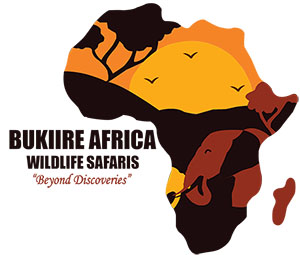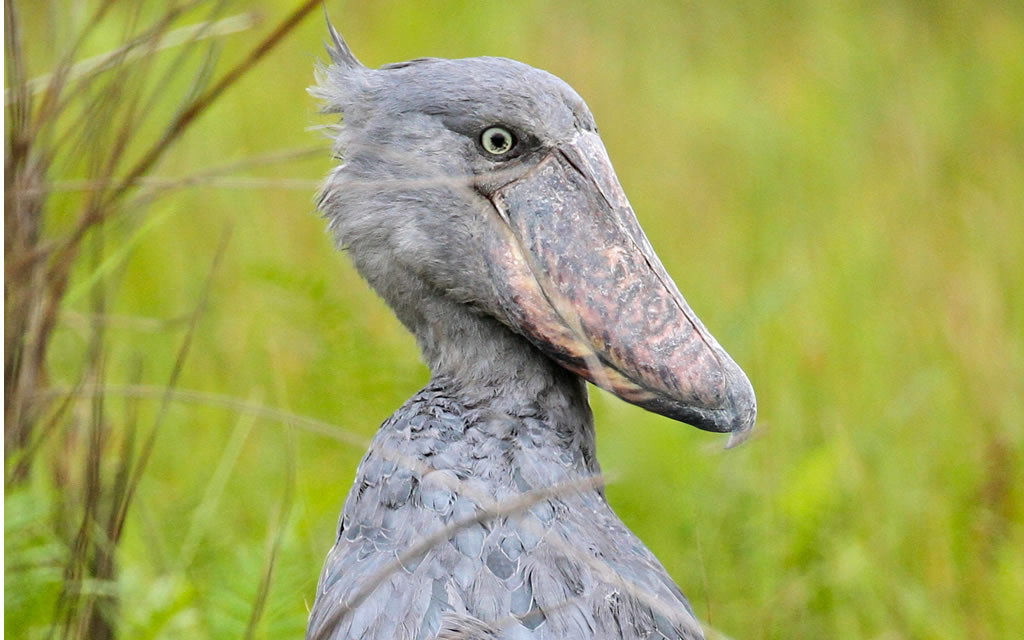Shoebill tracking at Mabamba Swamp derives her name from a local species of fish called “Mamba” (Lung Fish). High numbers of Lungfish used to be caught within the regions of the swamp hence the local people terming it, the area of Lung fish “Mabamba.”
Previously, the swamp covered an area of 2424 Hectares but currently extended to Makanaga Bay wetland and the surrounding wetlands hence covering 10424 Hectares. The vast Marshes on the stretch of Lake Victoria drainage system consisting of colorful wild water plants like waterlilies, papyrus, spear grass and more, offer an ever-green scenic landscape along the shores and towards the tail end of the lake. A variety of colorful bird species both migratory and residents, averagely 500 including the sought after Shoebill Stork are residents.
It is a 30 minutes cruse by a local speed boat from Entebbe landing Site of Nakiwogo to Mabamba Swamp. Alternatively, you could cross by ferry to the mainland and drive for 30 minutes through villages to get to Mabamba landing site.
Shoebill tracking experience-Mabamba swamp
A shoebill Stork is one bird believed to have never under gone evolution. A Dinosaur-like bird of relatively larger size inhabits in East Africa with higher chances of sighting in Uganda. It is rare and unique in appearance, also ranked among the vulnerable species on the list of International Union for Conservation of Nature, with less than 3000 birds left on earth. When in Uganda, the story seems different as the bird can be sighted in different regions of the country. However, higher chances being at Mabamba Swamp.
The shoebill tracking experience involves use of local speed boats run by local site guides that always monitor the location, behavior pattern and safety of the Shoebills. Passing through the narrow water ways or paths created within the wetland while viewing a variety of other colorful bird species makes the whole experience breathtaking! Birds like Goliath Herons, African Jacanas, Egrets, Kingfishers, Warblers and Weaverbirds among others, are inevitable to watch! Shoebills being solitary birds and rare to encounter, Mabamba Swamp offers over 80% chance of viewing this sought after bird. The activity in general may take 5-7 hours to and from the swamp while residing within Kampala and Entebbe areas.
Birding at Mabamba Swamp-Uganda
With averagely 500 bird species both migratory and residents, Mabamba Swamp is a Bird Haven that core birders must not miss! A part from the sought after Shoebill Stork, other rare bird species are the Lesser Jacana, Papyrus Gonolek, Papyrus yellow Warbler, Africa Pygmy Goose, Rufus headed heron and blue swallows among others. The bird diversity and the short time at which they are watched, at a close proximity ranks Mabamba Swamp as one of the Birders hot spots. While on a local canoe, the silence along the created water trails offers higher chances of listening to bird calls and viewing them. Apart from the rare species, a variety of colorful water birds like Egrets, Cormorants, Herons, Jacanas, Ducks, Eagles, Kingfishers, Kestrels, Harriers and many others can be sighted.
The boundary between the swamp and land offers a variety of other terrestrial and arboreal bird species. Through agricultural fields, surrounding trees and wild flowers, birds like Sunbirds, Turacos, Plantain Eaters, Sparrows, weavers and fly catchers among others can be seen. For a core birder, a full day trip is highly recommended.
Where to stay during your visit at Mabamba Swamp
There is quite a number of accommodation facilities to choose from depending on your tour plan. You could decide to Pass a night in Entebbe and transfer to Mabamba swamp in the morning by boat or road and return later in the afternoon. If you are to connect to another destination after your activities, either carry packed lunch or order hot lunch at any of the lodges within Mabamba like Nkima and Mabamba Safari Lodges.
When is the right time to visit Mabamba Swamp
Uganda’s climate is made up of two seasons; dry and wet. The Wet season runs from Mid-March to May and October to December while the dry season resumes from January February then June until September. The dry season therefore is the right time to visit Mabamba Swamp. Birds are in abundance; water levels are lower and accessibility is conducive. Chances of Shoebill sightings are as well higher compared to the wet season.
The activity has no fixed time to start but highly recommended in the morning. If you are residing in Entebbe Peninsular, endeavor to setoff by 7:00 AM so that in an hour you have arrived. In the Morning, birds are active than any other time of the day.
What to prepare for shoebill tracking and Birding in Mabamba Swamp
Some times the weather can be unpredictable, you are therefore advised to always carry rain gear with you regardless of the prevailing climatic conditions. In Uganda it may shine in the morning and after an hour, it rains. The reverse is also true.
Apply insect repellent before boarding the local speed boat. You are likely to encounter bugs during the activity.
If possible, endeavor to participate in the morning schedule other than afternoon. This is because birds can still be active hence a better experience.
With you, carry binoculars, a hat, East Africa bird book, sun screen, enough drinking water and snacks. This is because you spend much of the time on water than land during the above activities.
Always keep the life Jacket on and follow instructions of your guide during briefing.
10 Days of Gorillas and the Big 5 Safari In Uganda
16 Days, 15 Nights of Primates and Wildlife in Uganda and Rwanda
17 Days of Primates and Wildlife in Uganda and Kenya
18 Days Exclusive Mountaineering and Big 5 Safari

